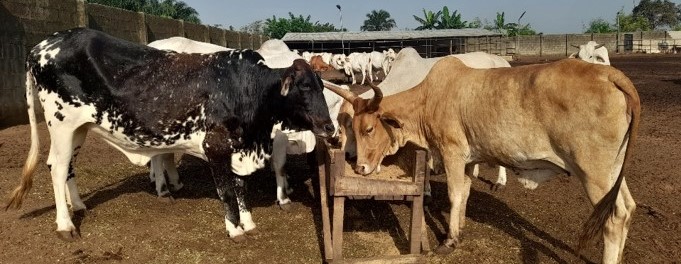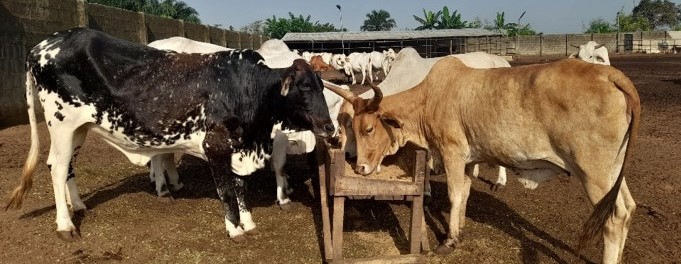

Beef cattle production with zero grazing is rapidly becoming a favored method among cattle farmers, especially in regions with limited grazing land. This approach involves confining cattle and providing them with all their nutritional needs. Let’s explore the benefits of zero grazing and delve deeper into how to implement this method effectively.
Why Zero Grazing?
Zero grazing offers numerous advantages, making it a viable and sustainable option for beef cattle production:
1. Efficient Land Use:
– Benefit: Zero grazing allows farmers to raise cattle on smaller plots of land, making it ideal for urban and peri-urban areas where land is scarce and expensive.
– Implementation: Construct well-designed barns and feedlots to house your cattle, ensuring you optimize the available space.
2. Better Nutrition Management:
– Benefit: Farmers have complete control over the cattle’s diet, which can lead to improved growth rates and meat quality. It also allows for the incorporation of high-quality forage and supplements.
– Implementation: Work with a livestock nutritionist to formulate a balanced diet that includes forage, concentrates, and mineral supplements. Use locally available resources like maize silage and hay to reduce costs.
3. Disease Control:
– Benefit: By keeping cattle confined, farmers can more easily monitor and manage health issues, reducing the risk of disease outbreaks common in free-range systems.
– Implementation: Implement regular health checks and vaccinations, and maintain a clean environment to prevent disease spread.
4. Enhanced Productivity:
– Benefit: Zero grazing systems often lead to higher productivity as cattle expend less energy foraging and can convert feed into meat more efficiently.
– Implementation: Develop a consistent feeding schedule to ensure cattle receive adequate nutrition throughout the day, promoting better weight gain and overall health.
5. Environmental Sustainability:
– Benefit: Zero grazing can help in managing manure and waste more effectively, reducing environmental pollution and promoting sustainable farming practices.
– Implementation: Set up a waste management system to collect and compost manure, which can then be used as fertilizer for crops.
How to Implement Zero Grazing
Implementing a zero grazing system requires careful planning and execution. Here are the key steps to get started:
1. Infrastructure Development
– Housing: Construct spacious, well-ventilated barns to house the cattle. The barns should be designed to facilitate easy cleaning and waste management.
– Feeding Areas: Designate specific feeding areas with feed troughs that minimize waste and contamination. Ensure there is ample space for all animals to feed comfortably.
– Water Supply: Install automatic waterers to provide a constant supply of clean, fresh water.
2. Nutrition Management
– Balanced Diet: Formulate a balanced diet that includes high-quality forage, concentrates, and mineral supplements. Use locally available feed resources to reduce costs.
– Silage and Hay: Incorporate silage and hay into the diet to ensure a year-round supply of nutritious feed. These can be made from maize, sorghum, or other local crops.
– Feed Schedule: Establish a consistent feeding schedule to ensure cattle receive adequate nutrition throughout the day.
3. Health and Hygiene
– Regular Health Checks: Schedule regular veterinary visits for vaccinations, deworming, and health monitoring.
– Cleanliness: Keep the housing and feeding areas clean to prevent disease outbreaks. Implement daily cleaning routines and proper waste disposal.
– Biosecurity Measures: Enforce strict biosecurity measures to prevent the introduction and spread of diseases. Limit access to the farm and disinfect equipment regularly.
4. Breeding Management
– Selective Breeding: Use selective breeding techniques to enhance desirable traits such as growth rate, meat quality, and disease resistance.
– Artificial Insemination: Consider artificial insemination to introduce superior genetics and improve herd quality.
– Calving Management: Provide adequate care during calving and ensure newborn calves receive colostrum within the first few hours to boost immunity.
5. Waste Management
– Manure Handling: Collect and store manure properly to use as fertilizer for crops. This helps in recycling nutrients and reducing waste.
– Composting: Implement composting techniques to convert waste into valuable organic fertilizer.
– Wastewater Treatment: Ensure proper treatment of wastewater to prevent contamination of water sources.
Examples of Successful Zero Grazing in Africa
1. A & A Harmony Farms, Nigeria: Located in Ogun State, Harmony Farms has successfully implemented zero grazing for beef cattle production. Their approach includes advanced nutrition management and modern housing facilities, resulting in high productivity and profitability.
2. Send a Cow Project, Uganda: This initiative has helped numerous smallholder farmers adopt zero grazing. By providing training and resources, the project has improved livelihoods and increased beef production in the region.
3. Galana Ranch, Kenya: A large-scale example, Galana Ranch uses zero grazing methods to optimize beef production. The ranch’s success is attributed to strategic feeding practices and robust health management systems.
Conclusion
Zero grazing offers a sustainable and profitable alternative to traditional grazing methods, especially in areas with limited land resources. By following these best practices, farmers in Nigeria and across Africa can enhance their beef cattle production, ensuring better health, higher yields, and increased income. This method not only supports the growth of the agricultural sector but also contributes to food security and economic development in the region.
If you found this information valuable and want to delve deeper into advanced strategies and expert tips, consider subscribing to our premium content or joining our exclusive farming community. Your journey to successful cattle farming starts here!